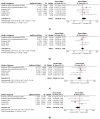Stereotactic radiosurgery for vestibular schwannoma: International Stereotactic Radiosurgery Society (ISRS) Practice Guideline
- PMID: 29296459
- PMCID: PMC5675503
Stereotactic radiosurgery for vestibular schwannoma: International Stereotactic Radiosurgery Society (ISRS) Practice Guideline
Abstract
Objectives: The aim of this systematic review was to develop International Stereotactic Radiosurgery Society (ISRS) consensus guideline statements for vestibular schwannoma.
Methods: A systematic review of the literature was performed up to April 2015.
Results: A total of 55 full-text articles were included in the analysis. All studies were retrospective, except for 2 prospective quality of life studies. Five-year tumour control rates with Gamma Knife radiosurgery (RS), single fraction linac RS, or fractionated (either hypofractionated or conventional fractionation) stereotactic radiation therapy (FSRT) were similar at 81-100%. The single fraction RS series (linac or Gamma Knife) with tumour marginal doses between 12 and 14 Gy revealed 5-year tumour control rates of 90-99%, hearing preservation rates of 41-79%, facial nerve preservation rates of 95-100% and trigeminal preservation rates of 79-99%.There were 6 non-randomized studies comparing single fraction RS versus FSRT. There was no statistically significant difference in tumour control; HR=1.66 (95% CI 0.81, 3.42), p =0.17, facial nerve function; HR = 0.67 (95% CI 0.30, 1.49), p =0.33, trigeminal nerve function; HR = 0.80 (95% CI 0.41, 1.56), p =0.51, and hearing preservation; HR = 1.10 (95% CI 0.72, 1.68), p =0.65 comparing single fraction RS with FSRT.Nine quality of life reports yielded conflicting results as to which modality (surgery, observation, or radiation) was associated with better quality of life outcomes.
Conclusions: There are no randomized trials to help guide management of patients with vestibular schwannoma. Within the limitations of the retrospective series, a number of consensus statements were made.
Keywords: acoustic; neuroma; schwannoma; systematic review; vestibular.
Figures
References
-
- Anderson TD, Loevner LA, Bigelow DC, et al. Prevalence of unsuspected acoustic neuroma found by magnetic resonance imaging. Otolaryngol Head Neck Surg. 2000;122(5):643–6. - PubMed
-
- Lin D, Hegarty JL, Fischbein NJ, et al. The prevalence of “incidental” acoustic neuroma. Arch Otolaryngol Head Neck Surg. 2005;131(3):241–4. - PubMed
-
- Stangerup S-E, Caye-Thomasen P, Tos M, et al. The natural history of vestibular schwannoma. Otol Neurotol. 2006;27(4):547–52. - PubMed
-
- Tos M, Stangerup S-E, Cayé-Thomasen P, et al. What is the real incidence of vestibular schwannoma? Arch Otolaryngol Head Neck Surg. 2004;130(2):216–20. - PubMed
LinkOut - more resources
Full Text Sources
Miscellaneous


